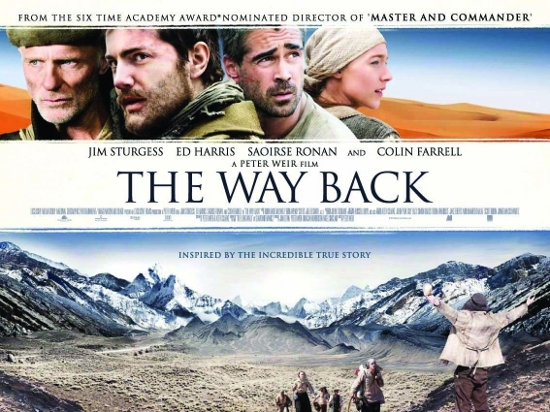
“The Way Back,” released in 2011, is based on the 1956 book “The Long Walk,” by Slavomir Rawicz. I don’t know why they changed the name. They weren’t going “back,” because they were going to India, rather than “back” to Poland. It was just a long, long walk. But I’m sure some studio executive had infallible rationale.
I read “The Long Walk” in 2010, and reviewed it in July 2010. It was quite an astounding book of determination and endurance. During World War 2, a group of seven prisoners in a Siberian prison camp, most of them sentenced for political crimes against the paranoid Russian state, escape and head toward freedom in British-governed India. That meant traveling 4000 miles through a big piece of Russia, Mongolia, Tibet, and finally India. They circled Lake Baikal, traversed the Gobi Desert (where 2 of them died), and journeyed across the Himalayas. Truly amazing stuff.
They were never chased, never really threatened except by the elements and starvation. So I expected the movie to inject a relentless pursuit by a sadistic prison-camp commander. But director Peter Weir stayed true to the book. It was just the story of their long walk. Or way back to wherever.
The lead character was played by Jim Sturgess, an actor I wasn’t familiar with; he did very well. Colin Farrell played a violent, tattooed criminal who hooks up with the political prisoners; this character was not in the book, but was added for some dramatic (and I would say harmless) effect. Then there was Ed Harris, who played an American engineer, “Mr. Smith,” who went to Russia during the Depression to work on the subway system, and ended up being imprisoned. This was one of the more interesting characters in the book, and in the film.
Then there was Saoise Ronan, a young Irish actress who is taking the world by storm, and deservedly so. She played Elena, a Polish girl who was sent to a Siberian women’s camp, and escaped. The male escapees–most of them Polish–stumble upon her. In the book, Elena proved to be a delightful addition to the group, bringing cheer and hope. Ronan brought out that quality perfectly. I was pleased.
Of the eight characters in the group, I would say only four of them are well drawn. The others are pretty much indistinguishable.
The movie states at the beginning that only three persons emerged from the Himalayas. So you know something happens to the other 5 persons. The movie doesn’t play it true-to-the-book with some of them, but I didn’t feel it hurt the story’s essence.
What I didn’t like was the ending. At the movie’s start, the Russians torture Rawicz’ wife into accusing him of being a spy. Throughout the movie, Rawicz wants to get back to his wife and personally forgive her, knowing that she would live in torment until he could do that. But none of this is in the book. The way Peter Weir rushed through decades of Soviet occupation and brought the movie to a conclusion…it was contrived, and didn’t work for me.
But still, this was a great story, right up there with “Endurance,” the story of the Shackleford expedition to Antarctica. It wasn’t a great movie, but it’s an amazing tale. However, to really understand the depths of the ordeal they went through, read the book. The movie only touches the surface.
Having said all that–there is dispute about the accuracy of Rawicz’ story, that it never actually happened. That he was released in 1942 in a general amnesty of Poles in the USSR and sent to Iran. I was concerned, in the book, that nothing has been heard of the other trek survivors. But I leave this controversy to others.





